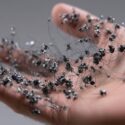Eight legs, eight eyes, sharp fangs, and bullet-proof webs. They’re hairy, they’re scary, and now, they’re human-sized. As many as 427 million people around the world suffer from arachnophobia.
Are you one of them? Viewer discretion is advised.
Don’t be misled by the “Itsy Bitsy Spider!” Not all spiders are tiny, and they’re definitely not helpless.
Arachnids are smart, fast, cunning, and they’re cold-blooded killers. Their appetites are insatiable, their numbers are unbelievable.
The combined weight of the world’s spiders is 25 million tons. And they eat as much as 725 million tons of insects every year!
So what if spiders were the same size as humans? You might find yourself in a very sticky situation.
It’s estimated that 3.5% to 6% of the global population suffers from arachnophobia. But in a world where spiders are the same size as humans, who wouldn’t be scared of them?
There are roughly 40,000 different spider species, and if they’re as big as us, they’re all dangerous – even the Bagheera kiplingi, which is famous for being the first “mostly vegetarian” spider known to science.
If you think you’d only have to worry about venomous or carnivorous spiders, you’re dead wrong! If they’re not venemous, they can still be hungry.
And even when they’re not hungry, you’ll want to look our for their giant legs, which could trample you, or their huge webs which could expose you to all sorts of deadly risks!
Aside from the obvious fear of having your insides liquefied, and being consumed from the inside out, depending on how long you’re caught in a web, you also risk death from hunger or exposure. Spider webs can be hard to spot sometimes, and most of us have walked into one on more than a few occasions.
But in a world where spiders are the same size as us, watching out for webs would be a matter of life and death!
When measured quantitatively by weight and diameter, a spider’s silk can be five times stronger than steel, and two to ten times as strong as Kevlar – the stuff that bulletproof vests are made from.
But something else you should know about spider webs is that they’re not entirely sticky. Sticky strands of silk are often alternated with non-sticky strands, which the spider walks around on. So if you did run into a human-sized web, it’s not guaranteed that you’d get stuck instantly.
That said, a spider has eight legs compared to your two. Vibrations rippling across its web would inform a spider of your intrusion, and in seconds, it would be bearing down on you.
You’d have to act fast. If, for any reason, you happen to be carrying a machete or a blowtorch, your chance of survival is a lot higher. But if you don’t happen to have either of those items with you, you’ve got one more trick up your sleeve!
It’s your sleeve. Learn a trick from moths and butterflies. They have a layer of scales on their wings that they can shed if they ever get caught.
So, when you’re stuck, just take off your clothes and run! Now, running desperately for your life in the nude sounds either incredibly terrifying or… incredibly liberating …depending on how you feel about it.
But whatever your outlook on life may be, anything beats the alternative. The Goliath Birdeater spider provides a nice example as to why…
Weighing in at about 170 grams (6 oz), and with a 30 cm (12 in.) leg span, this is the world’s biggest spider. The Goliath Birdeater has two fangs that are longer and sharper than a cheetah’s claws, but that’s not even the scariest part!
When the Goliath Birdeater bites, it injects its prey with paralyzing venom that turns the prey’s insides into liquid, so that they can be sucked out of its body. So, realizing in your final moments that a spider will be having you in juicebox form for dinner – that’s the scariest part.
As you know, the world used to be filled with giants. Even before the dinosaurs, the world was populated by enormous insects!
A world in which spiders are the same size as humans would be far from harmonious. We’d likely be in a constant state of war, with nest raids for population control, and we’d need frequent patrols to get people unstuck.
Considering how much spiders eat, how fast they move, and how cunning they are, we could never let our guard down. But how long could we keep it up?
For millenia, humans have dominated the world. We’ve triumphed over every beast, even the ones that are bigger than us. But would human-sized spiders lead to our day of reckoning?
Or maybe it would be the complete opposite! Have you ever wondered what would happen if all insects disappeared from the planet?
Subscribe to What-If on YouTube or follow the show on Facebook Watch.
Sources
- “Spiders eat astronomical numbers of insects”. 2019. Sciencedaily. Accessed November 28 2019.
- “Gigantic Spider Webs Made Of Silk Tougher Than Kevlar”. BRANDON KEIM, WIRED. Accessed November 28 2019.
- “What is a spider’s silk made of?”. Howstuffworks. Accessed November 28 2019.
- “Goliath Birdeater”. 2018. nationalgeographic.com. Accessed November 28 2019.
- “Web gigantism in Darwin’s bark spider, a new species from Madagascar (Araneidae: Caerostris)”. Kuntner, Matjaž, and Ingi Agnarsson. 2010. Journal Of Arachnology 38 (2): 346-356. American Arachnological Society. doi:10.1636/b09-113.1.
- “Scientists Untangled Spider Web Stickiness”. Cimons, Marlene. 2010. livescience.com. Accessed November 28 2019.
- “Spiders ‘Listen’ To Web Tones To Detect Prey”. 2019. Discover Magazine. Accessed November 28 2019.
- “Wings allow escape from spider webs“. Asknature. Accessed November 28 2019.




























This article doesn’t really take into account the Square Cube Law. A giant spider would be far to heavy to support its own weight, and we can already sort of see this with larger species of Turantula, who despite their size, are fragile and can even die from falling from a small height.